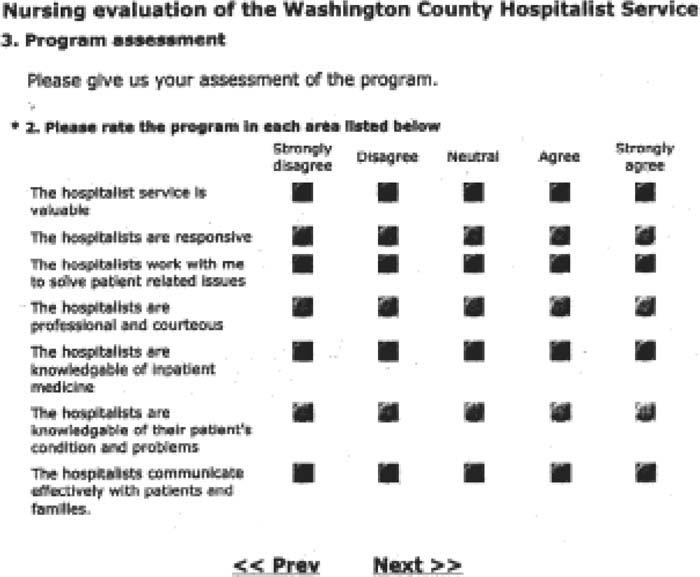Background:
A hospitalist program serves numerous stakeholders: patients, hospital administration, primary care physicians, and nursing staff, to name a few. It is imperative to gauge hospitalist performance as evaluated by these stakeholders. Although surveying patients and primary care physicians is now the established norm, there was a need to create a nursing satisfaction survey. This survey should ideally be clear in its objectives, user friendly, reproducible and cost effective.
Purpose:
The purpose of the study was to determine hospitalist performance through the measure of nursing satisfaction
Description:
We created and implemented a Web‐based questionnaire call NURSVEY (for nursing survey). Alow‐cost ($20/month) Web‐hosting vendor was identified, and NURSVEY was created as an online questionnaire spread over4 screens that could be completed at work or at home in less than 3 minutes. Although each nurse respondent was asked to identify his/her unit or floor, the survey was anonymous. It was open for a month at a time and offered twice a year. To avoid any undue bias that could hinder or compromise the validity of the survey, hospitalists and/or program directors were not granted access to the survey while it was ongoing. The figure shows one of the NURSVEY screens.
In our setting, a national hospitalist management company, the survey was rolled out to all our client hospitals. The nursing administration at every client hospital was approached several days before the launch of the survey. The nurse manager at each institution provided all nursing staff with the URL of the survey. In several hospitals, NURSVEY was linked to the hospital's LAN or VIN
Results were monitored by the regional medical director. Various filters were applied to obtain hospital‐specific data or to review agency‐wide data in order to compare programs at various hospitals within our client network. Feedback was then provided to the hospitalist physicians. An executive summary was provided to the hospital administration and the nurse managers.
Conclusions:
In the present pay‐for‐performance atmosphere, NURSVEY has proven itself a useful tool to assess hospitalist performance from a nursing perspective. The data are useful for assessing specific nursing unit concerns, physician effectiveness and response time, and nursing education needs. It also allows for ongoing evaluation to improve acceptance of the hospitalist program and to incorporate nursing suggestions into the day‐to‐day operations of the hospitalist program. NURSVEY provides the opportunity to improve nurse‐hospitalist collaboration and to better address patient care needs.
Author Disclosure:
F. A. Daniels, None; S. Syed, None; M. Wagner, None; M. S. Baran, None.

